-
Posts
1,190 -
Joined
-
Last visited
Content Type
Profiles
Forums
Gallery
Events
Posts posted by Bedford
-
-
Michael
Me too! I have a fair idea of how it will all pan out but once i have mounted the prop shafts there will be a LOT of thinking and planning to see what has to go where. Oh, and shopping too.
Robbyn
Thanks, I have learned to read the planks and how they want to lie, I run them in a compromise position between where I want them to lie and where they want to lie favouring their choice a bit then I fill the gaps later. It has turned out quite well. I'm glad I have you fascinated, hopefully I will pull this off well and not disappoint.
-
At last, the planking is finished !
Now to fill the gaps and seal the hull inside and out. I am not going to be too keen to get a smooth perfect finish because these schooners were made of timber and therefore imperfect and I think a few irregularities make a hull look better than glass smooth, they give it character.
I am happy with the stern, it looks about right given pics I have seen
When I finished the planking and turnd her over I was surprised at how much bigger she looks from the inside that the outside, I may have to call her "The Tardis"
-
I think we all know how good it feels to be at this point.
I am pretty happy with the way the planks have come together but just to show it's not all like that, here is a better shot of the stern planking. It looks awful at this point but bear in mind the planks were just long enough to reach so short filler pieces will need to be added, some have already been done. I find the stern is never as easy as the bow, especially when it is a modern style bow, but it will all come good in the end.
-
Apparently 4.5 pounds is about 2 Kg so hopefully I will have plenty of ballast to play with.
Anyone want to guess the finished weight to get her to float at the waterline?
-
A few progress pics, Robbyn you can see the planking looks great at the bow but is a real mess at the stern, that's the way the planks flow. Once all the long planks are in place the stern filler pieces will be fitted slowly but surely and it will look almost as good as the bow.
I am weighing her now and then and the frame was 900 gramms, at this stage she is 1.15Kg.
With masts and bowsprit she is 1.4Kg.
I am going to have to build lightness into her somewhere because I want as much weight in the keel as she can carry.
-
I am waiting for a replacement prop shaft assembly to arrive from the UK, it should be here soon. I won't be looking at mounting anything internally until i have the hull fully planked and both prop shafts mounted. I have to work out the size of servo spools I need to perform the operations I require so I can work out where the servos will mount.
I was going to mount all the servos in the deck houses but I think a few may need to go below decks because of the diameter that I think may be required
-
Shaz, she is my fifth ship so I have a bit more experience than you but you'll get there.
I am not following someone else's instructions on how to build it so I can do it the way that suits me and make it up as I go. The best part is the rabbet I created, especially for the bow, it makes the job so much easier because all I have to do for that end of the plank is cut the end of an off cut plank to the correct angle to lie in properly which can take a couple of attempts to get just right, then I use it as the template for all the planks that intersect with the bow rabbet at that angle. When the angle changes I re-cut the template to suit. There are a few messy bits but they will come good as I put all the filler pieces in.
The big thing is dry fitting. First I lay an off cut across each frame to see if it will lie against the previous plank properly. If not it is because a bit of glue has squeezed out when the previous plank was clamped so I use a knife and trim that away until it sits properly. I also mark where the plank will lie while doing this so I can pre-drill for the planking screws. I only do this in the area in which I know where the plank will lie, ie hold it against the hull and see where it is happy to lie.
Since the planks are only a little bit short I can use the bow plank to see the lie of the entire plank, all the way to the stern but I cut the bow plank around frame 7 or 8 and start the stern plank there before the big twist back to the stern starts so there is no join in this stressed area and the plank flows properly.
I cut the bow angle on the plank and attach it with clamps and planking screws marking exactly where I want to lay it which is generally a trade off between where I want it to go and it wants to go. I tend to let the plank lie where it wants to more or less because then it is less stressed and less likely to give that "klinker" finish. On a hull like this there is no need to steam and bend the planks because all the bends are gentle and in this case quite long and lazy.
Only when I have done all this and then re-fitted the plank with clamps etc to make sure it sits where I have selected to fit it do I open the glue bottle. I apply glue to the side of the previous plank and the the frames then start attaching the plank from the bow back using lots of clamps and planking screws.
It takes up to an hour to fit a plank but as you can see it is coming together very nicely and neatly. I am not quite so fussy with a static model unless it is single planked like the Schooner for Port Jackson was.
Bob, you're not talking about thinning the epoxy with scotch are you??
That's a good bit of info and I assume you are talking isopropyl alcohol.
I can see me thinning the epoxy and using it inside and out to get it into the timber properly and make the whole thing stronger and more impervious to water. Then using normal consistency epoxy for a couple of coats with a thickenned epoxy for filling internally.
As for the wife's nylons.....................I'm divorced and don't think she would be very happy if I asked

- avsjerome2003 and fnkershner
-
 2
2
-
Epoxy can be a glue as you mention but it is all manner of things with all manner of uses, two parts mix to make it and it is what is applied to fibreglass sheet to make it set into whatever you are making, it can be painted onto a surface to protect, strengthen and waterproof it. The list goes on.
-
John, I have a pic of her somewhere that shows she was green, I have just spent a bit of time googling her and came up with one pic of the hull under tow, she looks green but it is far too distant to bother posting.
That's all academic anyway, she is black now but I think a nice green would look better for my schooner. That's the thinking at this stage.
-
Floyd, yes I want to see her sail so I will be coming along for the ride !!
If I could find a way I think I would submerge her in epoxy and then let her drain and set. I am thinking all the time about how I am going to get epoxy into all the gaps and think I will do the exterior first to seal it then do a thick coat on the interior to gap fill but yes epoxy is my new friend.
Michael, You are so right, even though I bought more clamps I still only have enough to do one side at a time at this stage because the planks are really trying to go "klinker" through these bends so one at a time for now and get it right. The planks are 5mm x 1.5mm so they are stiff enough to be easy to work and shape so they fit together well while still being easy enough to twist and bend to shape.
-
-
G'day mate, you've got a deal.
I have looked into shipping and handling and I reckon about 5 grand should cover it.

The planking continues, and continues................
I went and bought more clamps so I can do more than one plank at a time but have a look how many clamps I need to attach one plank.
Trouble is because she is going to be single planked and go to sea I need to keep the planks glued to each other and aligned to each other, without the clamps between ribs you tend to end up with a "klinker" style hull which can be sanded of course and have a nice thin veneer layed over to make nice but in this case there is none of that. I want to keep sanding to a minimum so I keep hull strength. I can of course use filler in this build as it will be epoxied and painted. I am thinking a mid green which the James Craig was when towed from her watery grave in Tasmania to Sydney.
- augie, avsjerome2003, mtaylor and 2 others
-
 5
5
-
Well Floyd if you where in the WA that I am familiar with (Western Australia) you would be quite a bit warmer than I am at the moment. Still, you get that !
Consider this, by the time the Schooner is ready to launch it will be too damn cold here to do so therefore she will have to lie in dry dock waiting for warmer weather.
-
No progress pics but I am having to do something I have never had to do before. The planks are 900mm long and I am having to join them to reach from stem to stern.
That's not a bad thing as it turns out because it is getting warm here and the hull is so long that by the time I have applied glue to all the ribs and the edge of the plank then attach the plank clamping all the way by the time I get a bit over half way along the glue is skinning over.
- augie, Shazmira and avsjerome2003
-
 3
3
-
Jerry I have been reading your build logs today and there are some good ideas there, too late for me to go down that path now though so I will continue and see how it goes.
Yambo I have been wondering about the need for glass, the hull will be pretty strong, The planks are 1.5 mm thick and there is a ton of strength in the keel so I might just go with a good coat of resin or two.
I am not looing forward to working with glass, it is a bugger.
When you talk about "thickened" is that the way you buy it or is there an additive.
-
I build my hulls with Titebond III
What do you seal them with?
Augie, 5 min epoxy would not give me long enough to apply it all the way along the edge of a 1 metre plank and to all the frames and fit the plank, making sure it is properly seated and clamped all the way along.
I am planning to fibregalss the exterior and epoxy coat the interior pending better ideas.
Steve
-
mmm don't handle ca either from memory..............
I have thought of using ca along the plank joints rather than running a bead of glue along them and clamping them together. I would glue the planks to the frame with the normal stuff then just run a line of ca along the join but I don't trust ca for such a big project that will be put to sea as it were.
-
See, I knew I wouldn't need to post pics.....
I just wish there was a glue that would stay wet for 20 minutes then when pressed between two surfaces would dry in 5 seconds.
The waiting for glue to dry so clamps can be removed before attaching the next piece is a real drag.
-
Thanks, I have seen that one before, ages ago. He cheats and turns the whole mast but she looks good under sail.
I am pleased you posted it because I had forgotten about it and the keel and rudder size are helpful.
It also appears that he has a false deck which is interesting.
Anyway a little bit of progress, the first plank is on, there won't be a lot of pics of the planking because, well, we've all been there done that.
-
Just a little tangential thinking but she actually looks quite good as is and were I the type to display bare boned models it would actually look quite good. You can see all the lines etc and the masts finish her off well.
Don't worry though, I don't do bare boned models.
-
I was thinking of making an extended keel out of mild steel that would just attach under the keel and run its length but on reading other builds I decided to go with a detachable sailing keel and have been giving a lot of thought as to how to mount it before planking. Still not sure how I want to make the keel but I have worked out how I can mount any keel I make so planking will commence soon.
The keel will be deep to get the ballast well below the hull and as has been said I can fiddle with it until it is right.
I do wish she had a deeper draft because that would mean more ballast but I think I can overcome that if needed by adding a false polystyrene bottom with the keel thus giving her a deeper sailing draft but only if it becomes necessary.
Always thinking ahead, the joy of scratch building something you know very little about. That's why I do it though, to think and learn.
- mtaylor and avsjerome2003
-
 2
2
-
As promised, some interesting pics
The masts and bowsprit seats are installed so I set her up to see what she looks like and the first impression......................BIG!
The proportions seem right so I am very happy with it.
This is how I seated the masts. The seats are drilled through at 86 degrees then glued and dowelled to the keel. In hindsight I should have milled a rebate in the bottom of them so they straddled the keel but it was late and I didn't think of it. They will be hidden anyway so function is all that matters.
-
As an ex RC sailor I'm enjoying your build. She's looking fine.
Bob
Bob, I will welcome any input you have that might help me get this right. As I said before I like working things out myself but if you can see something going the wrong way please speak up.
The only sailing experience I have is aboard the James Craig recently so I really am winging it with this but it's what I like, learn as you go.
I already have doubts as to the depth of the hull, being a coastal vessel she has a shallow draft. I was going to get the plans enlarged 300% horizontally and 350% vertically to give me a deeper draft but I decided to stay true to plan. A deeper draft would have meant more freeboard so a dryer deck and more weight in the sailing keel so less likely hood of being knocked down under sail. I may add a plank or two to the sides to make her a bit taller but I think she will be ok. Looking at the water line and trying to imagine how much water she will displace I think there will be a good few kilos to play with.
As a side note my Schooner for Port Jackson weighs in at 370 grams complete and the frame alone for this schooner weighs 900 grams.
Steve
-
Popeye I have a long 6mm drill bit so I should be able to handle the ribs where ever the tubes need to run. I may need to make some infill blocks to fill areas that might be hard to drill because of angles and proximity to edges but between the drill bit and the dremel I shouldn't have too much trouble.
There might be an interesting pic later today......

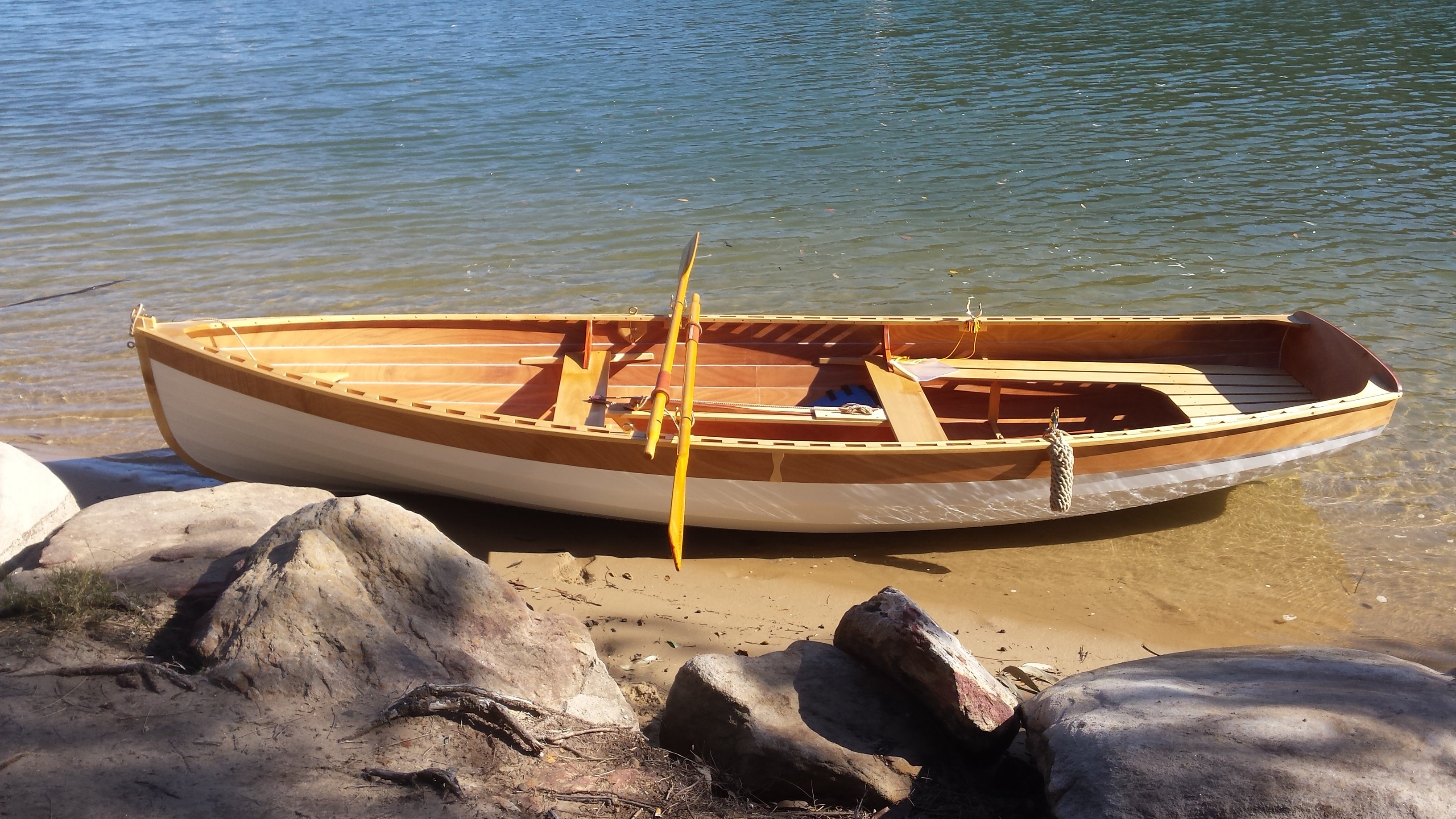

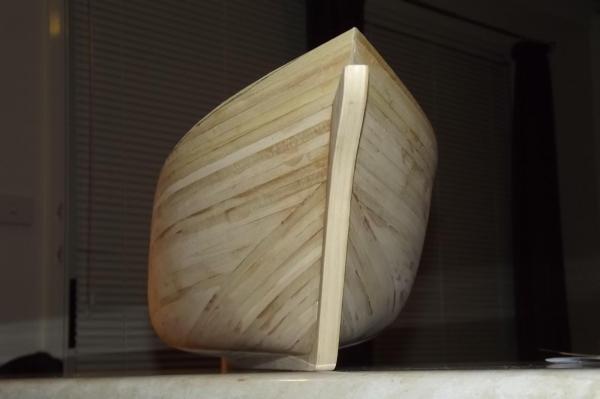
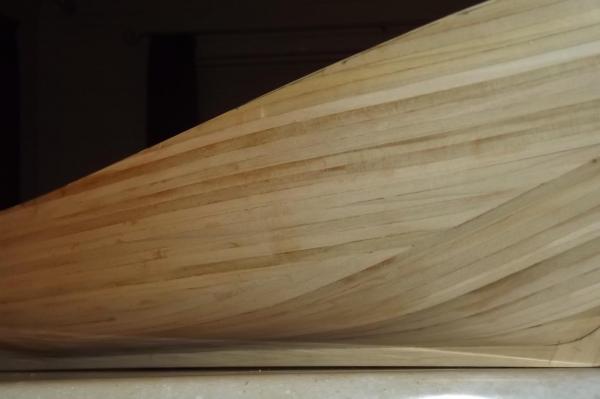
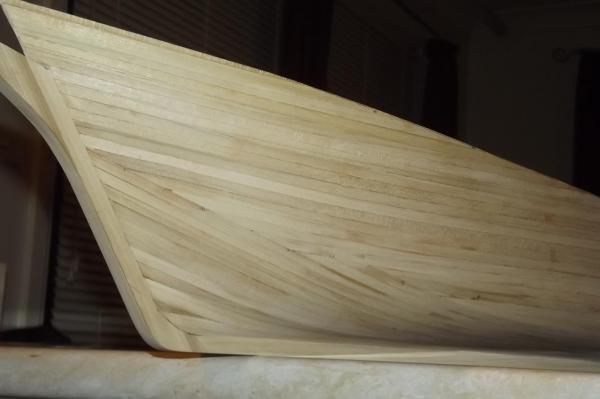
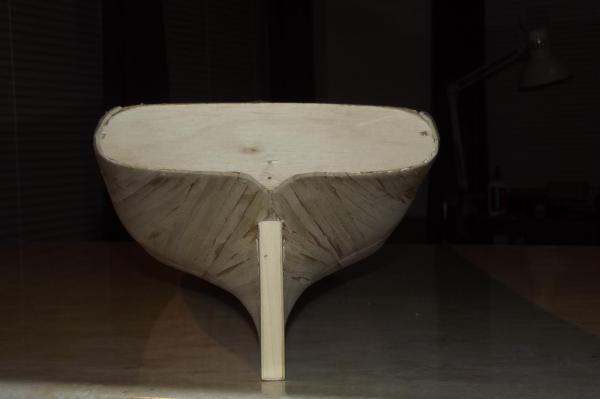
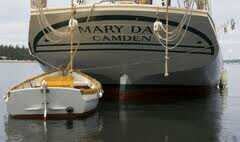
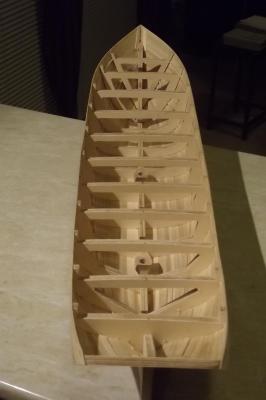
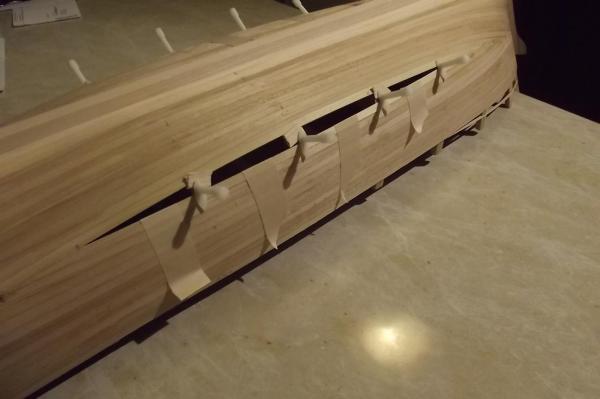
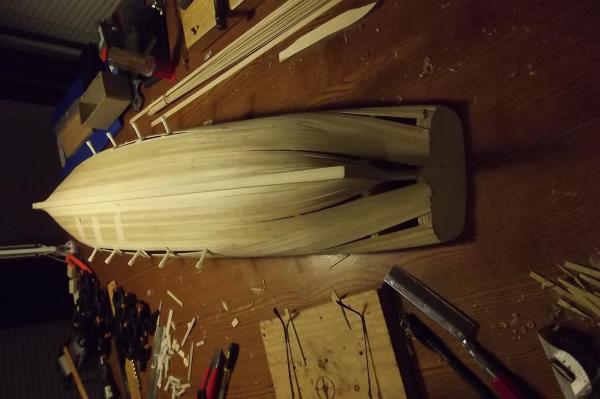
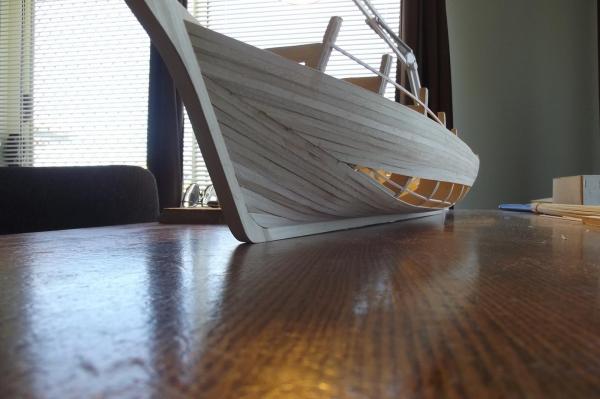
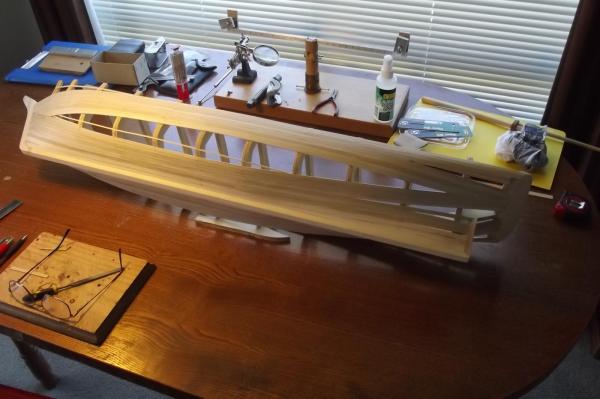
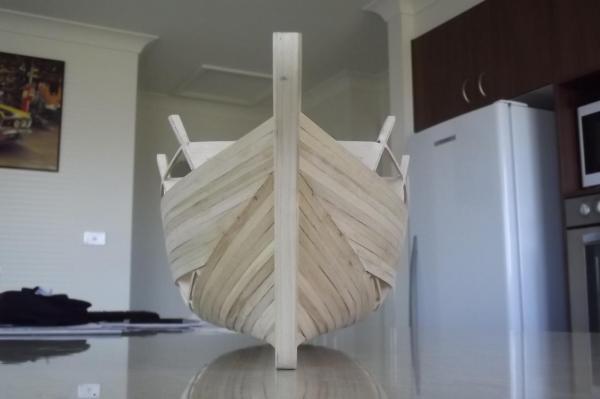
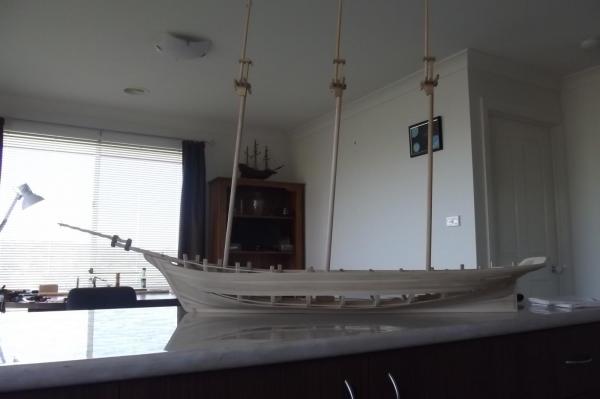
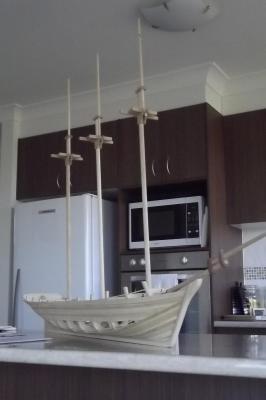
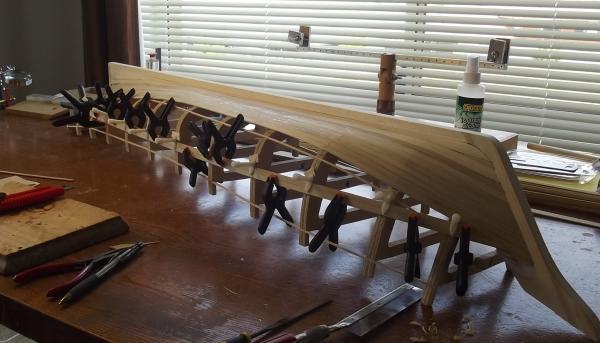
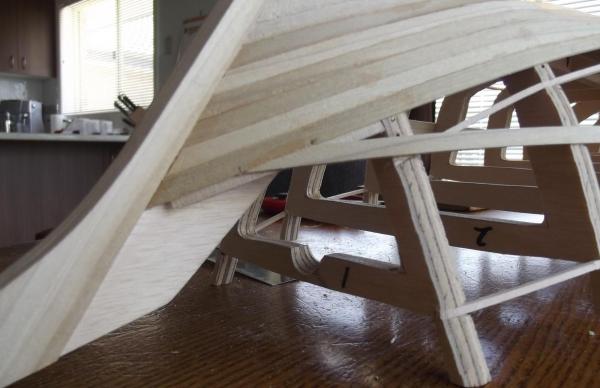

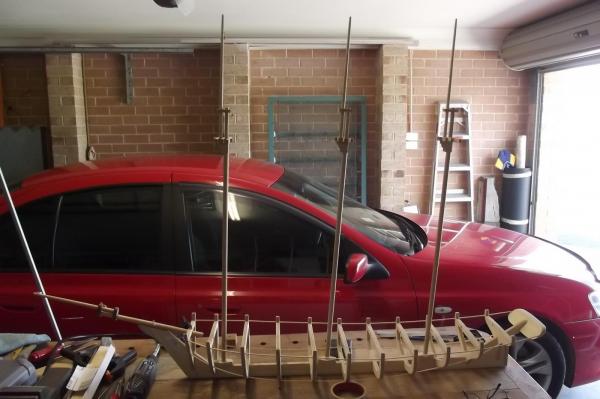
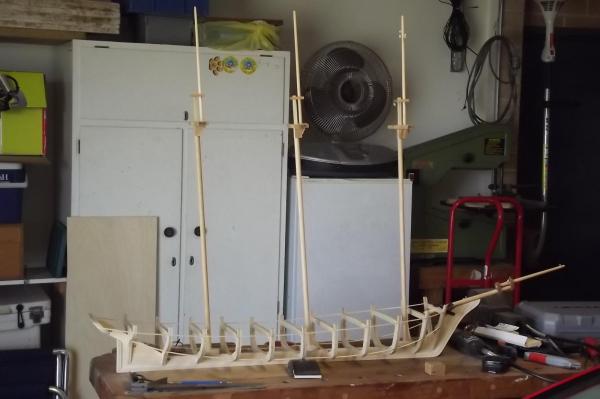
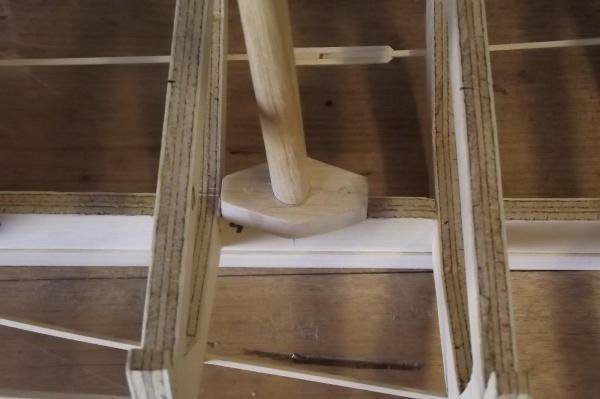
Maine three-masted schooner by Bedford - 1:54 - RADIO
in - Build logs for subjects built 1851 - 1900
Posted · Edited by Bedford
I have made the first hole in the hull, for the bow sprit. Now you can see her real lines for the first time.